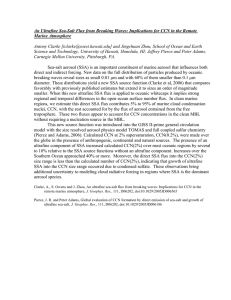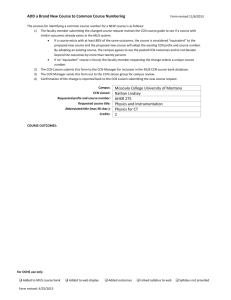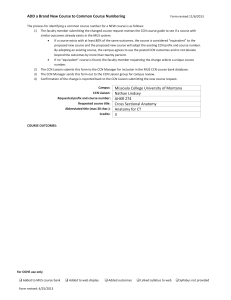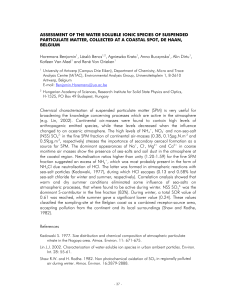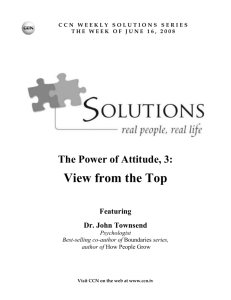Source Fluxes of Remote Oceanic Aerosol: Ultrafine Sea-Salt, Sulfate and CCN
advertisement
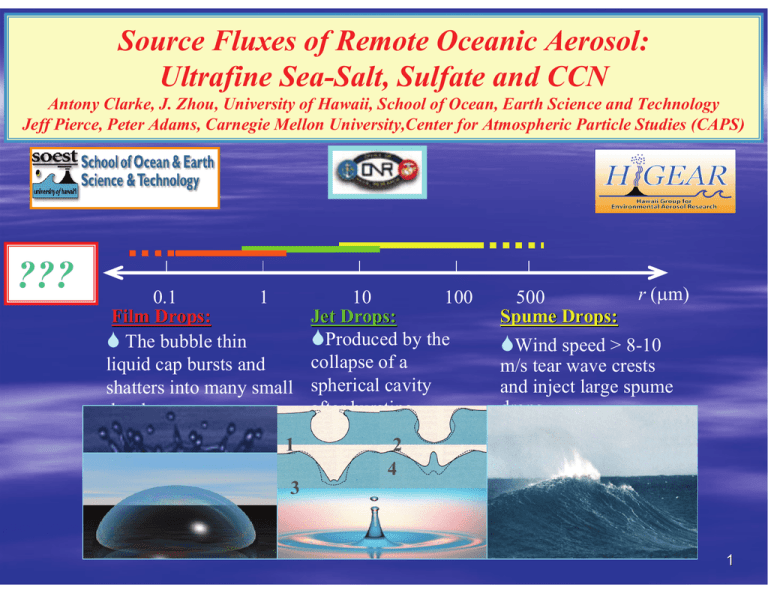
Source Fluxes of Remote Oceanic Aerosol: Ultrafine Sea-Salt, Sulfate and CCN Antony Clarke, J. Zhou, University of Hawaii, School of Ocean, Earth Science and Technology Jeff Pierce, Peter Adams, Carnegie Mellon University,Center for Atmospheric Particle Studies (CAPS) ??? 0.1 1 Film Drops: 6 The bubble thin liquid cap bursts and shatters into many small droplets. 1 3 10 100 Jet Drops: 6Produced by the collapse of a spherical cavity after bursting. r (μm) 500 Spume Drops: 6Wind speed > 8-10 m/s tear wave crests and inject large spume drops 2 4 1 Overview Natural Sea-salt largest aerosol mass flux globally. Sea-salt particles down to 10nm from breaking waves. Size resolved number flux for 100% bubble coverage is scaled to open ocean flux vs. wind speed. Relative contribution of SSA to CCN flux into MBL (Dp>80nm) compared with entrainment of sulfate from Free Troposphere. Global influence on CCN using CTM model (Pierce and Adams, 2006) 2 UH Tower – Bellows AFS 20m 10m 5m 10m 20m 4 Hour Period on Julian Day 119, 2000 5m View from top of tower 3 Small particles vary with coarse scattering O Waves break, produce foam, and dissipate over about a distance of 20m and enhance CN and light scattering O There is a linear relationship between CN (small particles) & scattering (large particles) (R=.93) 4 Particles Produced from Breaking Waves down to 0.01um are stable at 350C – like Sea-Salt Similar distributions for heated (350C) and unheated particles from breaking waves suggest sea-salt. Cumulative Optically active Average refractory distributions reveal 60% of number found in sizes below 0.1 um, previously uncharacterized. 5 Flux into bottom of box = Flux out of side of box S100 [ Aavg L + 0.5 wo] τ dl = Cs k (Vw ) h τ dl S100 = Cs k (Vw ) h / [ Aavg L + 0.5 wo] S100 has units of [#/cm2 s ] number of aerosols produced per unit area of 100% bubble covered surface per second Cs = Measured mean BW CNhot (background removed) at 5 m (30 cm-3 ± 5.3 cm-3) k = Multiplier for tower Cs compared to mean profile (1.5 ± 0.3) Vw = Mean surf zone wind speed (7.3 m/s ± 1.1 m/s) h = Height of plume layer for beach profile (4 m ± 0.6 m) Aavg = Mean bubble fractional coverage area between waves (0.4 ± 0.12) L = Distance wave travels to shore (35 m ± 3 m) wo = Initial width of BW bubble front (2 m ± 0.5 m) APPROACH Assume bubbles from ocean whitecaps have similar distribution to coastal waves. Monohan 1986 Determine flux for 100% bubble coverage from COASTAL breaking waves and scale to OPEN OCEAN based upon whitecap coverage for given wind speed. 7 Source Function (# /cm2/s) comparison for 9 m/s whitecaps using nominal Monohan whitecap coverage This study - SEAS coastal ocean 2003 De Leeuw – coastal 2001 MN93 Martensen wave tank 2003 M86 - Monahan wave tank 1986 LS04 – Lewis and Schwartz Book, 2004 8 QUESTION? With this new SS number fluxWhat is the importance of Sea-Salt as a source of CCN for the Clean Marine Boundary Layer compared to “sulfate” entrained from the Free Troposphere? Activated CCN Clarke, A.D., et al., Particle production in the remote marine atmsophere: Cloud outflow and subsidence during ACE-1, Jour. Geophys, Res., 103, 1998 9 Comparison of Nominal SS Surface flux and FT Sulfate Flux for various Wind Speeds and Entrainment Rates Nominal CCN, Dp>80nm WS=15m/s 10m/s FT Entrainment at 0.8 cm/s; 0.4 cm/s; 0.2 cm/s 5m/s 10 COMPARE refractory particles in two regimes (scatterometer data) Christmas Island Located in low wind from E at (<4 m/s) subsidence zone with FT source of volatile sulfates Hawaii Located in region of moderate Trade Winds (>7m/s) from NE 11 Estimated % contribution of Sea-Salt to total CCN flux > 80nm for various wind speeds and entrainment rates Wind Speed > 5 ms-1 10 ms-1 15 ms-1 (6 cm-2s-1) (64 cm-2s-1) (254 cm-2s-1) FT Entrainment 0.2 cm s-1 20 % 73 % 91 % 11% 58 % 84 % 6% 41 % 73 % (23 cm-2s-1) 0.4 cm s-1 (46 cm-2s-1) 0.8 cm s-1 (92 cm-2s-1) 12 SSA Flux Conclusions • Small particles down to ~10nm diameter are produced by BW. • About 60% of total number flux are smaller than 100nm. • Chemically confirmed to be SSA down to 90 nm . • Over half of these SS sizes are introduced as effective CCN (Dp>80nm). • SSA appears to be major contributor to global natural CN and CCN fluxes. 13 Putting This SSA flux in GCM model GISS II – prime Models SSA concentrations and not just fluxes Allows interaction with sulfur cycle (Adams and Seinfeld, 2002). Global Evaluation of CCN Formation by Direct Emission of Sea-Salt and Growth of Ultrafine Sea-Salt Jeff Pierce and Peter Adams JGR-Atmospheres, 2006 14 Motivation Sea-salt source function uncertainty Sea-salt impact on cloud condensation nuclei • All sea-salt • Ultrafine sea-salt Uncertainty in indirect effect 15 Wind driven emissions in model underestimated 3.41 U Model U 3.41 NCEP = EmisModel Emis NCEP Model underpredicts sea-salt emissions by about 30% compared to NCEP reanalysis 16 Model Details NASA Goddard Institute for Space Studies GCM II-prime – – – 4° latitude x 5° longitude 9 vertical layers between surface and 10 mb One hour tracer time step Two Moment Aerosol Sectional (TOMAS) aerosol microphysics algorithm – Explicitly calculates both aerosol number and mass in each size section – 30 size sections (~10 nm - ~10 μm) – Sea-salt and sulfate aerosols only 17 Models Runs Run Name Sea-salt Emissions Include Ultrafine Sea-salt SULF None NA CLRK MART MON OD Clarke, 2004 Martensson, 2003 Monahan, 1986 O'Dowd, 1997 yes yes no no CL100 MA100 Clarke, 2004 Martensson, 2003 no no 18 Model evaluation Sea-salt Mass Distribution Andreae et al. [1999] MART CLRK 19 Model evaluation Marine Number Distribution Ultrafine seasalt emissions consistent with observations over S. Ocean Observations from Heintzenberg et al. [2000] 20 Sea-salt impact on cloud condensation nuclei All sea-salt CCN(0.2%) Concentrations (cm-3) Sulfate only Sea-salt and Sulfate (CLRK) 21 Sea-salt impact on cloud condensation nuclei All sea-salt CCN(0.2%) - Percent Change relative to sulfate 22 Sea-salt impact on cloud condensation nuclei CCN(0.2%) Percent Change from Ultrafine Sea-salt Increases in CCN greater than could be explained without microphysics Condensation of sulfate onto UF sea-salt dominant growth process Similar uncertainties in cloud forcing 23 Uncertainty in Indirect Effect Typical Marine Stratus Cloud P 0.6 P P 0.5 MART Albedo C C OD 0.4 ΔA = 0.075 C ΔA = 0 .12 0.3 P -3 Liquid water content = 0.3 g m Cloud Height = 100 m 0.2 0 25 50 75 100 125 150 175 200 -3 Cloud Droplet Number Concentration [cm ] C C = clean marine region P = polluted marine region 24 Cloud Forcing Estimate for Southern latitudes (following Seinfeld and Pandis, 1998) 1) Clean unpolluted marine region and nominal supersaturation of 0.2% 2) averaged over clear and cloudy sky Varies by 4 W/m2 for different SSA emission scenarios Increases by 1 W/m2 due to presence of ultrafine SSA in model [ this implies uptake of sulfate on SSA moves ultrafines into CCN active sizes ] 25 CONCLUSIONS Model results with new SSA emission flux Model shows best agreement with observed size distributions for Clarke SSA emission flux Three fold increase in CCN over Southern Ocean 50% increase over parts of Atlantic Range of forcing differences for SSA flux up to 4 W/m2 over S. Ocean Ultrafine SSA interact with sulfate to grow to CCN Important to get “clean” CCN correct if forcing due to perturbations is to be assessed. 26
